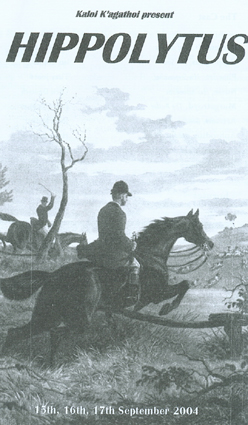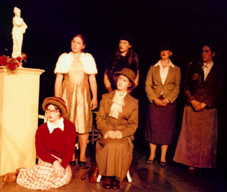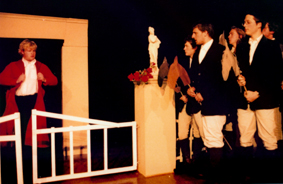
News & Events
Hippolytus: A Tragedy In The Making
Kaloi K’agathoi is a fledgling theatre company, specialising in classical drama and working in collaboration with Hereford Cathedral School’s Classics and Drama departments. Previous productions from this vibrant retinue include Euripides’ Electra, Aristophanes’ Frogs and Menander’s Dyskolos, all staged in the School’s Powell Theatre, thanks to the endless patience and selfless assistance of Head of Drama, Lucy Zammit. For this year’s venture we returned to our Euripidean roots with the playwright’s surviving version of the Hippolytus, currently studied as part of the OCR AS level Classical Civilisation syllabus.
 Hippolytus
is, in many respects, a difficult play. We sought to put on a production
that was challenging for both the cast and the audience and that offered
more than straight tragedy:
a musical, as the original production would of course have been, and one
that brought out the parodic, fin-de-siecle approach to the traditional
versions of the myths which caused such controversy amongst contemporary
audiences. Directing this adventurous performance of
‘Hippolytus’ were Simon Andrews and Kerrith Davies, whilst Christina Robinson
carried the dual burden of leading the female chorus and producing the
play. These three, all Old Herefordians, were invited back by Siobhan
De Souza, Head of Classics and Company Manager, whose boundless enthusiasm
has inspired so many pupils at HCS. Simon suggested setting the play
as a 1930s country house murder mystery, without the murder. Simon explains
‘the themes of social snobbery, sexism and hunting lend themselves to
this setting and provide an opportunity to make the choruses more easily
accessible to a modern audience’. Kerrith and Christina set about making
the necessary changes to the Penguin text used for the AS prescription,
often working from the original Greek. The amended script was ready for
auditions, which took place at the end of the Spring Term.
Hippolytus
is, in many respects, a difficult play. We sought to put on a production
that was challenging for both the cast and the audience and that offered
more than straight tragedy:
a musical, as the original production would of course have been, and one
that brought out the parodic, fin-de-siecle approach to the traditional
versions of the myths which caused such controversy amongst contemporary
audiences. Directing this adventurous performance of
‘Hippolytus’ were Simon Andrews and Kerrith Davies, whilst Christina Robinson
carried the dual burden of leading the female chorus and producing the
play. These three, all Old Herefordians, were invited back by Siobhan
De Souza, Head of Classics and Company Manager, whose boundless enthusiasm
has inspired so many pupils at HCS. Simon suggested setting the play
as a 1930s country house murder mystery, without the murder. Simon explains
‘the themes of social snobbery, sexism and hunting lend themselves to
this setting and provide an opportunity to make the choruses more easily
accessible to a modern audience’. Kerrith and Christina set about making
the necessary changes to the Penguin text used for the AS prescription,
often working from the original Greek. The amended script was ready for
auditions, which took place at the end of the Spring Term.
Auditions and Casting:
Despite the number of both present and past pupils who auditioned, the production team was able to adhere to its policy of finding a suitable role for all those wishing to participate. We endeavoured to give the majority of the principal parts to current pupils, whilst allowing seasoned veterans to tread the boards once more. The auditions were open to the whole school, making this an all-inclusive production and confirming ‘The Classics Play’ as part of the school’s theatrical calendar. It was clear from the outset that we were very fortunate to have two terrifically talented actors to do justice to the difficult roles of Phaedra (Tizzie Jones) and Hippolytus (Ian Corder) - and sing like pros too. Theseus, also a part for a singing voice, was played by OH Dom Lacey (left July 2003) and the Nurse by Chris Deutsch, now U6, and, like many, a veteran in his third classical production. The goddesses were played by Jodie Mallet (OH, left July 2002) as Artemis and Hannah Lewis (U6) as Aphrodite, with her evil minion Murgatroyd, the butler (John Crichton III, left 2003). Theseus’ maid was Luce Edwards, who bravely wore black to care for Jonty de Souza (playing Montmorency, the dog).
The elegant chorus was led by Christina Robinson, Aunt Jane to Phaedra’s
entourage: Sarah Hunter-Choat (L6), Elizabeth Dollins (OH, left 2003),
Rosalind Higman (L6), Lily Fieldhouse (L6) and Rowena Hatfield (L6). 
Hippolytus’ huntsmen, a dream to choreograph, were: Thomas Bilbrough (L6), Tom Campion (L6), Tom Cohn (2004), David Barton-Grimley (left 2004), Edward Mundy (left 2004), Gethen Jacobs (U6) and Peter Deutsch (L6).
Rehearsal:
We rehearsed the play in one week during the summer holiday. The amount of progress made in such a short space of time was a true testament to the skill and dedication of the cast and crew. During this time the cast were drilled on singing, acting and the diction of the 1930s. Having two directors ensured that all members of the cast were occupied during rehearsal and allowed other directorial tasks such as technical design and musical arrangement to be undertaken without inconvenience to the rehearsal schedule. Rehearsals began with a read-through, followed immediately by blocking. Kerrith worked closely with the cast, discussing the meaning and significance of their lines and actions in order to ensure the creation of a convincing performance.
Design:
The first and perhaps most important part of the production to be designed was the set. Combining the classical and neo-classical styles, the set consisted of a number of pillars that represented both Theseus’ palace and gardens at Trozen. The set was thus highly versatile, allowing us to change location without interrupting the free running of the play. Statues of the goddesses Aphrodite and Artemis were used to represent the disparate forces at work in the drama, which were brought out by the positioning of the characters and choruses in relation to these statues. Despite its versatility and visual appeal, the set was in fact constructed at relatively little cost during the limited rehearsal period, almost single handedly by Paul Tandler (left 2004), with a little help from Ed Painter (OH, left 2003) and his slick backstage team, Frances Leech, Kerri Middleton, Vicki Frith and Jack Grundy (all L6).
 Costuming
the play authentically was paramount to establishing the period and style
of the production for the audience and also aiding the cast in finding
a character-handle for their roles. All those appearing on stage, including
the stage team (who conducted scene changes in character in full view
of the audience), were in period costumes, with the exceptions of the
goddesses Aphrodite and Artemis. This was done in order to emphasise their
timeless omnipresence and disassociation from the mortal characters in
the play. Theseus’ first, slightly comic shooting costume was changed
in the latter scenes to more stately, dignified evening wear in order
to emphasise the tragic nature of the downfall of the House of Athens.
1930s make up was essential to the atmosphere, and flawlessly applied
by Georgia Hutchinson (OH, left 2003).
Costuming
the play authentically was paramount to establishing the period and style
of the production for the audience and also aiding the cast in finding
a character-handle for their roles. All those appearing on stage, including
the stage team (who conducted scene changes in character in full view
of the audience), were in period costumes, with the exceptions of the
goddesses Aphrodite and Artemis. This was done in order to emphasise their
timeless omnipresence and disassociation from the mortal characters in
the play. Theseus’ first, slightly comic shooting costume was changed
in the latter scenes to more stately, dignified evening wear in order
to emphasise the tragic nature of the downfall of the House of Athens.
1930s make up was essential to the atmosphere, and flawlessly applied
by Georgia Hutchinson (OH, left 2003).
Lighting and sound (courtesy of Richard Brooks, left 2004) were used to convey the passage of time and location, e.g. birdsong and green-tinted lighting for garden scenes. This naturalistic lighting was supplemented by specific effects during climatic moments and songs.
Music:
In order to maintain the musical tradition of Greek theatre we selected a number of contemporary songs to convey mood and atmosphere. The lyrics were re-written to replace some of the choral odes and provide additional information and background to the characters and action of the play, much in the style of the original Greek choruses.
The music was performed by our highly talented four piece jazz band: Liam Dunachie (piano, 5 Form), who arranged the score, David Greatrex (guitar, U6), Alex Summers (percussion, 3 Form) and Christobel Hunting (trumpet, left 2004) and performed in a style consistent with the period setting.
PS
We were most grateful for a generous grant this year from the Hellenic Society, which went a long way towards production costs. We had originally set this aside to put towards a professional filming of a performance, but this proved unnecessary owing to the kindness of Mr. Greatrex, who produced a most impressive video of the last night – already in use in the Classics Dept. as a valued teaching aid. The theatre was filled to capacity on each of the three nights, and we were much heartened by the roar of appreciation that accompanied the applause as the notes of the finale died away. But perhaps the greatest feeling of all was experienced during the hush each night as Theseus bowed his head over his dead son and, looking down from the lighting box, we saw the odd punter moved to tears.
